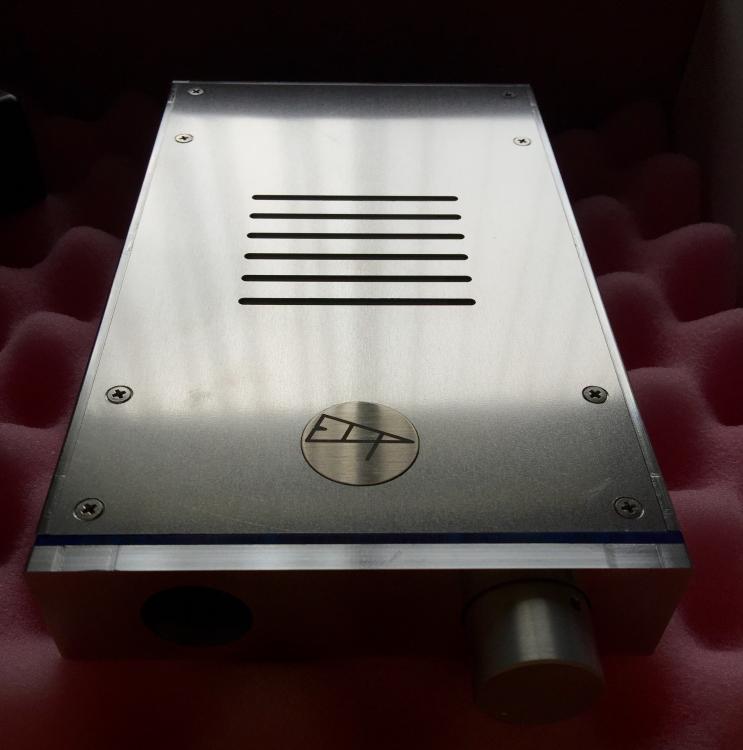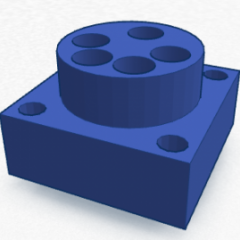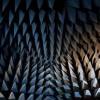Leaderboard
Popular Content
Showing content with the highest reputation on 09/16/2015 in all areas
-
7 points
-
Hmmm had a post typed and it didn't go through for some reason... Anyhow, the amp was in gestation for some 9 months. Last December I bounced some ideas off of Doug for an amp for the JH16s but kinda fizzled out over time. This past summer I got a new roommate who studies at home as well so I couldn't use the speakers anymore to watch lectures or listen any music. Approached Doug again to design/build something that I couldn't head the noise floor of which had been the issue with all the amps I had tried in the past. Happy to report that I don't hear anything that I am not supposed to with this amp. Doug calls it the DB3 - Diamond Buffer V3 and man does it buffer the shit out of whatever it is buffering. I gave full creative control of the amp to Doug and was very pleasantly surprised to open up the box. I had not seen any pictures of the amp prior. Was going to wait for finals to be over to plug it in but he mentioned something about a blue led so had to try. JH16s have never sounded better. Hooray for Doug2 points
-
2 points
-
Nate ...one of my favorite places on this earth, but, unlike you, I drive, or in the distant past, hike there. Congrats on the summit, and, I know by now, a safe descent. Cheers, brother ...2 points
-
2 points
-
Also not cooking but did some homemade guacamole for lunch. I love making it fresh but then I eat the fucking shit out of it way too quickly.2 points
-
Okay you asked for it. Here's a little from Saturday and Sunday. We're a pretty gimpy group, so didn't stray far. For the hell of it shot everything 21:9 (with the Sigma dp2 quattro). Compressed, though still a bit large on the bandwidth front. My apologies.2 points
-
She's got some great albums herself, and Trio M have a couple excellent ones. AP SACD:1 point
-
1 point
-
The publication date for the SRX Plus in AudioXpress has been pushed back a month, to Nov and Dec. The first part covers the amp circuit, which I’ve already discussed, and the second the power supply. In the interim, I thought I would start discussing the power supply. My raw power supply design is a bit different, in some ways a throwback to pre-World War II days. There isn’t really anything new about it, and in fact I used a similar design in a phono preamp project published a decade ago. Nor do I claim it is better or worse than current orthodoxy, but it is different, with both advantages and drawbacks that are worth discussing. Pretty much all the power supplies in Head-Case projects that I have seen are solid state rectifier capacitor input supplies. If you look at the schematic above, you will see that mine is a hybrid rectifier choke input filter supply. The bias supply is a direct steal from Dr. Gilmore - if you're going to steal, steal from the best. Transformer The first thing you may notice is the transformer has a higher secondary voltage than usual, although the ultimate output voltage is +/- 340V or so. This is because a choke input filter outputs a voltage that is close to the RMS voltage of the secondary, as opposed to a capacitor input filter, which outputs a voltage close to the peak voltage of the secondary – the latter is about 1.4x higher than the former. I used a surplus transformer with an electrostatic shield between primary and secondary to minimize the amount of noise and hash coming in through the AC line. The secondaries were specified at 780VCT center tapped/50 mA with two 6.3 volt/1.2 amp filament windings and a 5volt winding, which I used with a voltage doubler to power the HV delay (not shown). A separate 6.3V/1.6 amp transformer was used to power the 6BY5GA dual damper diode rectifier. Unfortunately the AC power line is often contaminated with noise and spikes from appliances turning on and off, light dimmers, etc. The electrostatic shield helps minimize the amount of power line crud that gets into the secondary of the power supply. It is found in transformers from Antek, for example, which a number of Head-Case members have used for their builds, and is routinely found in professional, industrial and medical electronics, but is generally missing in “high end” audio equipment. Rectification Every time a rectifier turns on or off it generates voltage spikes. These spikes produce broad band noise that has to be filtered out. The problem is that the high frequency noise generated is often not well shunted to ground by electrolytic capacitors and so gets passed down the line. The common 1N4007 diodes are among the worst offenders. Soft recovery diodes such as HEXFREDs or Schottky diodes, and tube rectifiers generate less noise, with tube damper diodes as a class generating the least noise. Tube rectifiers also turn on slowly, allowing the filaments of the signal tubes to warm up before the high voltage turns on. Of course tube rectifiers have their downsides: they need a filament supply, they wear out, and they cannot tolerate large input capacitors. Together with their relatively high impedance, this results in significantly less “stiff” power supplies, with DC voltage varying with changing demand. However, since most electrostatic headphone amplifiers are class A, differential and balanced, their current demand is pretty constant so a “soft” power supply isn’t too much of an issue. Since the SRX Plus needs a bipolar high voltage supply, a bridge rectifier is required. Implementing this with tube damper diodes would require 4 diodes and at least 3 filament supplies (the two positive legs of the supply can share a filament supply), which is a significant complication. As I was in an experimental mood when I built the SRX Plus, I used a hybrid rectifier with a 6BY5 dual damper diode tube for the positive legs and soft recovery diodes for the negative legs, and a HV delay and ramp up circuit from K&K Audio with an 11 second delay and a couple seconds ramp-up on the B- side to roughly match the turn on characteristics of the damper diode tube. This was an attempt to get some of the noise and turn on benefits of a tube rectifier while only needing one filament supply. This experiment was partially successful, in that there was a nice delay in HV, however, since the turn-on of the positive and negative halves were not perfectly matched, the amplifier output voltages initially went negative then positive, before drifting down to zero over 30 minutes or so (the drift being due to amp warm-up). While it can be a bit disconcerting watching the voltages moving up and down by a couple hundred volts or so within a few seconds, since the amp is fully differential, the positive and negative outputs tracked each other well, limiting turn on and turn off noises. For those who don’t want to bother with a tube rectifier, a regular solid state bridge rectifier would work. High voltage HEXFRED soft recovery or Shottky diodes would generate less noise than other solid state diodes. Filtering There are two ways of filtering the raw rectified AC, capacitor input filters and choke input filters. Pre WWII, when iron and copper were cheap and capacitors were expensive, choke input filters were the norm. Nowadays when iron is expensive and capacitors are cheap, capacitor input filters are nearly universal. However, there is one significant disadvantage to this topology. With a capacitor input filter, there are large current spikes, because the capacitor only fills up at the peak of the voltage waveform when the input voltage exceeds the voltage already on the capacitor. So during that brief period of time, there is a large current surge to top up the cap. These brief current spikes may peak at many amps even though the average current may be only a fraction of an amp. The late Allen Wright likened these spikes to whacking the power supply with a ball peen hammer 100-120 times a second. Those spikes produce lots of broad-band noise. Soft recovery diodes do little to reduce this source of noise as the current spike is largely independent of the type of diode it is running through. Tube rectifiers produce less of this, because their relatively their high impedance limits the amount of peak current during the spike. Thus, the strength of solid state rectifiers – their low forward impedance and ability to pass large currents to top up large capacitors, is also their weakness from the viewpoint of noise generation. Choke input filters avoid this source of noise because the current flows throughout the whole cycle, assuming a proper value choke, and so are inherently quieter. I feel it is preferably to generate less noise to begin with rather than trying to filter it out afterwards – an ounce of prevention, etc. Choke input filters also match well with tube rectifiers, which cannot tolerate a large capacitor input filter – most tube rectifiers are specified to work with input capacitors of 20-50 µf at most. The inductance of a choke acts like an electrical form of inertia to keep the current flowing during the downside of the voltage cycle to smooth the current flow. Finally, choke/capacitor filters do a better job of removing residual AC line crud (12 dB/octave) than RC filters (6 dB/octave). The output of a choke looks more like a simple sinusoid - easy for the filter caps to deal with. This also makes the job of the power supply regulator much easier. Even the simplest regulators have relatively high rejection ratios for hum and other low frequency garbage. Where they tend to have trouble is at high and ultrasonic frequencies where the rejection ratio diminishes. Note that these benefits only occur if the input section is a choke. If you use a capacitor input filter, you still have the large current spikes. A choke section down the line will help with noise filtering, but real world chokes have shunt capacitance that can still allow some high frequency noise to pass through. With choke input filters, there is no derating of the transformer needed. A transformer rated at 50 mA AC will easily supply 40-some mA DC current without strain with a choke input filter. With a full wave bridge cap input filter, the minimum AC rated current is 1.8 x the desired DC current. I used two LC sections each on the B+ and B- supplies – that’s four chokes and four capacitors, which is probably overkill. But the result is a nice, quiet raw power supply. In fact I used a single ended version of this with damper diodes, 20H primary choke and electrolytic caps on both sections as the raw power supply for my tube phono preamplifier, which has a passive power supply (if you’re interested, it was published in AudioXpress 1/04 and 2/04). If choke input filters are so great, why doesn’t everyone use them? Well, chokes are expensive, heavy, and bulky. My tube phono and line preamps and SRX headphone amp, which all have choke filtered supplies, weigh around 40 lbs each, and the power supplies occupy at least 2-3 times as much space as the active electronics – you cannot build a mini-SRX, or mini anything else, for that matter, using a choke filter power supply. Forget it if you want a small bedside table amp. Also, you need a higher output voltage from the transformer – the RMS voltage has to be higher than the final raw DC voltage. For a high voltage supply, sourcing transformers can be a problem. Antek does have 400 to 500V RMS secondary transformers if you’re willing to go to 400VA, which would be total overkill - not that there’s anything wrong with that. But it is additional buik, weight and expense. The 500V RMS would work for building a choke filter supply for a Blue Hawaii or +/-400 volt KGSSHV or Carbon, with 5-6H chokes, if you’re so inclined to experiment with choke filter supplies – just make sure you’ve got a strong back or a working fork lift. So, a different methodology for your consideration.1 point
-
Noted my friend! Tasted much better today than yesterday so by the time you get some it should be fantastic!1 point
-
yeah heisei fuzoku is one of the best, I didn't know it was a movie soundtrack either which makes a lot more sense with respect to the themes/lyrics do your mora DVDs also have video content? I've heard that if you put them into a video player there's some footage of ringo drawing Re: ripping, http://www.dvdae.com/dvdae/tutorial/cd , trying it out on a dvd rip I found1 point
-
Not really cooking but I made some salsa with my home-grown tomatoes and criolla sella peppers along with some habanero peppers and other stuff.1 point
-
Awesome video and pics above....! Me: spent Rosh Hashana (Jewish New Year) dinner with Karen and mother-in-law at her place's restuarant; we ended up with 2 others from the place who knew her. The wife is having some simpler memory issues but was very upbeat. The husband has major hearing issues but is an incredibly intelligent and funny man. He is 96, she is 89. What an interesting night! Turns out they spent a lot of time near where I grew up, and knew my grandparents, stepfather, and a cousin.1 point
-
Hiked up Mount Washington for our 25th wedding anniversary , finally got around to posting the vid:1 point









